
Teopanzolco is an Aztec archaeological site in the Mexican state of Morelos. Due to urban growth, it now lies within the modern city of Cuernavaca. Most of the visible remains date from the Middle to Late Postclassic Period (1300-1521). [1] [2]

Teopanzolco is an Aztec archaeological site in the Mexican state of Morelos. Due to urban growth, it now lies within the modern city of Cuernavaca. Most of the visible remains date from the Middle to Late Postclassic Period (1300-1521). [1] [2]
Teopanzolco comes from the Nahuatl language, it has been interpreted as "the place of the old temple". [1]
Teopanzolco was built upon a hill formed from a lava flow. Although this area is now occupied by the Vista Hermosa district of Cuernavaca, in pre-Columbian times it was an area of coniferous woodland. [1]
The Morelos Valley was settled from about 2000 BC. During the Classic Period, Teopanzolco came under the influence of the great metropolis of Teotihuacan in the Valley of Mexico. By the Postclassic, various Nahua groups had moved into the Altiplano ; the Tlahuicas founded nearby Cuauhnahuac (Cuernavaca) and Teopanzolco itself. They were conquered in 1427 AD by the Aztec emperor Moctezuma Ilhuicamina, after which they were integrated into the Aztec Empire and were obliged to pay tribute and participate in Aztec military campaigns. [1] [2] The prehispanic history of Teopanzolco was brought to a close by the Spanish Conquest in 1521, at which time the Tlahuicas were still living in the area and paying tribute to the Aztecs. [3]
Teopanzolco was probably the original centre of the city of Cuauhnahuac during the Early Aztec period (AD 1150–1350) before the ceremonial centre was moved to a more defensible location, now the centre of the modern city of Cuernavaca. [4] After the relocation of the ceremonial centre no new construction was undertaken at Teopanzolco. [4]
The site of Teopanzolco was rediscovered in the 1910s, during the Mexican Revolution, when the revolutionary forces of Emiliano Zapata installed an artillery emplacement upon the Great Platform (Building 1) in order to shell federalist positions in the centre of Cuernavaca. [5] The resulting cannon fire shook loose the soil, revealing the stonework below. [6]
The modern history of Teopanzolco begins with the first excavations at the site in 1921, no further investigations took place until it was excavated in 1956-7 by Mexican archaeologists Román Piña Chan and Eduardo Noguera, who investigated the temple of Ehecatl and established a ceramic sequence for the site. [2] Further archaeological investigations took place in 1968-9 (by Angulo Villaseñor) and in 1980 (by Wanda Tomassi). INAH has undertaken maintenance and minor excavations annually since 1985. [2]
The earthquake of September 19, 2017, damaged the main temple. As archaeologists began repairing the damage, they were surprised to find a smaller, previously unknown temple inside, which presumably was dedicated to Tlaloc, the god of rain. Archaeologists discovered stucco-covered walls, a bench, and a pilaster, which may date to the Posclásico Medio period (A.D. 1150-1200). While more studies need to be undertaken to prove this theory, this would mean that the temple of Teopanzolco predates the Templo Mayor in Mexico City. [7] [8]

Only the ceremonial centre of Teopanzolco has been preserved. The residential areas of the prehispanic city lie beneath the modern development of Vista Hermosa, for this reason the actual size of the city is unknown. The surviving remains were built using local basalt. Although nothing survives of the original finishing, the buildings were presumably covered with painted plaster, as at other archaeological sites. Although the site had been developed by both the Tlahuicas and the Aztecs, the dominant architectural style and the majority of the excavated ceramics are Aztec in origin. [1]
The site is in the care of the Instituto Nacional de Antropología e Historia (National Institute of Anthropology and History) and is open to the public.

Chacmool is the term used to refer to a particular form of pre-Columbian Mesoamerican sculpture depicting a reclining figure with its head facing 90 degrees from the front, supporting itself on its elbows and supporting a bowl or a disk upon its stomach. These figures possibly symbolised slain warriors carrying offerings to the gods; the bowl upon the chest was used to hold sacrificial offerings, including pulque, tamales, tortillas, tobacco, turkeys, feathers and incense. In an Aztec example the receptacle is a cuauhxicalli. Chacmools were often associated with sacrificial stones or thrones.
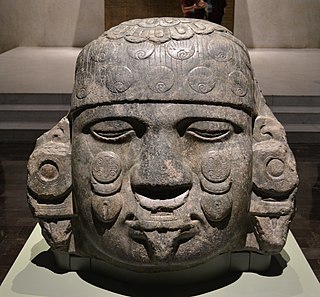
In Aztec religion, Coyolxāuhqui is a daughter of the priestess Cōātlīcue. She was the leader of her brothers, the Centzon Huitznahuas. She led her brothers in an attack against their mother, Cōātlīcue, when they learned she was pregnant, convinced she dishonored them all. The attack is thwarted by Coyolxāuhqui's other brother, Huitzilopochtli, the national deity of the Mexicas.
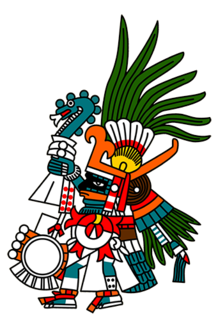
In the Aztec religion, Huitzilopochtli is a deity of war, sun, human sacrifice, and the patron of the city of Tenochtitlan. He was also the national god of the Mexicas, also known as Aztecs, of Tenochtitlan. Many in the pantheon of deities of the Aztecs were inclined to have a fondness for a particular aspect of warfare. However, Huitzilopochtli was known as the primary god of war in ancient Mexico. Since he was the patron god of the Mexica, he was credited with both the victories and defeats that the Mexica people had on the battlefield. The people had to make sacrifices to him to protect the Aztec from infinite night. He wielded Xiuhcoatl as a weapon, associating him with fire.
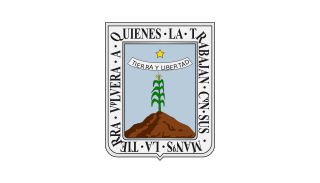
Morelos, officially the Free and Sovereign State of Morelos, is one of the 32 states which comprise the Federal Entities of Mexico. It is divided into 36 municipalities and its capital city is Cuernavaca.

Cuernavaca is the capital and largest city of the state of Morelos in Mexico. The city is located around a 90 min drive south of Mexico City using the Federal Highway 95D.

Xochicalco is a pre-Columbian archaeological site in Miacatlán Municipality in the western part of the Mexican state of Morelos. The name Xochicalco may be translated from Nahuatl as "in the house of Flowers". The site is located 38 km southwest of Cuernavaca, about 76 miles by road from Mexico City. The site is open to visitors all week, from 10 am to 5 pm, although access to the observatory is only allowed after noon. The apogee of Xochicalco came after the fall of Teotihuacan and it has been speculated that Xochicalco may have played a part in the fall of the Teotihuacan empire.

Miacatlán is a city and municipality in the Mexican state of Morelos. It stands at 18°45′N99°21′W.

Yautepec is a municipality located in the north-central part of the Mexican state of Morelos. The municipal seat is the city of Yautepec de Zaragoza. It stands at 18°53′N99°04′W.

The Templo Mayor was the main temple of the Mexica peoples in their capital city of Tenochtitlan, which is now Mexico City. Its architectural style belongs to the late Postclassic period of Mesoamerica. The temple was called the Huēyi Teōcalli[we:ˈi teoːˈkali] in the Nahuatl language. It was dedicated simultaneously to Huitzilopochtli, god of war, and Tlaloc, god of rain and agriculture, each of which had a shrine at the top of the pyramid with separate staircases. The spire in the center of the adjacent image was devoted to Quetzalcoatl in his form as the wind god, Ehecatl. The Great Temple devoted to Huitzilopochtli and Tlaloc, measuring approximately 100 by 80 m at its base, dominated the Sacred Precinct. Construction of the first temple began sometime after 1325, and it was rebuilt six times. The temple was destroyed by the Spanish in 1521 to make way for the new cathedral.
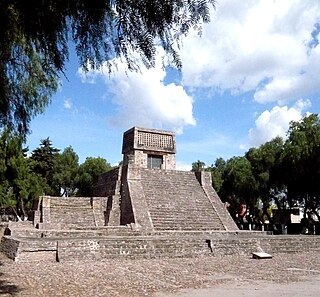
The Aztec religion originated from the indigenous Aztecs of central Mexico. Like other Mesoamerican religions, it also has practices such as human sacrifice in connection with many religious festivals which are in the Aztec calendar. This polytheistic religion has many gods and goddesses; the Aztecs would often incorporate deities that were borrowed from other geographic regions and peoples into their own religious practices.
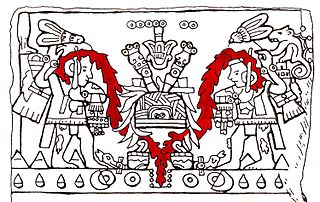
The Dedication Stone is a carved Aztec plaque made of polished greenstone. The plaque was found in 1845 in the location of present-day Mexico City. This plaque was made in commemoration of the completion of the sixth stage the Temple of Huitizilopochtli at Tenochtitlan in 1487. The dedication of the refurbished Great Temple was the final ceremony in becoming the emperor. Tizoc ruled from 1481 until 1486, after his death his brother Ahuitzotl succeeded him and ruled from 1486 until 1502. Expanding the Great Temple of Tenochtitlan, dedicated to the gods Huitzilopochtli and Tlaloc, was the duty of each tlatoani. Tizoc began the expansion of the Great Temple and his brother Ahuitzotl finished the project. According to the Codex Mendoza this was an important time for the Aztec society, they became an imperial civilization, with Ahuitzotl conquering 45 new towns. The ceremony of the re-dedication of the Temple involved so many sacrifices that the ceremony lasted for four days. Where this panel was located originally is unknown. Other panels similar to this one were usually placed into the architecture like stairways and pyramid platforms. Very similar stones have been found at the Great Temple of Tenochtitlan also known as the Templo Mayor and it is believed that this plaque might have been a part of those.

Tenayuca is a pre-Columbian Mesoamerican archaeological site in the Valley of Mexico. In the Postclassic period of Mesoamerican chronology, Tenayuca was a settlement on the former shoreline of the western arm of Lake Texcoco. It was located approximately 10 kilometres (6.2 mi) to the northwest of Tenochtitlan.

Tlatelolco is an archaeological excavation site in Mexico City, Mexico where remains of the pre-Columbian city-state of the same name have been found. It is centered on the Plaza de las Tres Culturas. On one side of the square is this excavated Tlatelolco site, on a second is the oldest European school of higher learning in the Americas called the Colegio de Santa Cruz de Tlatelolco, and on the third stands a mid-20th-century modern office complex, formerly housing the Mexican Foreign Ministry, and since 2005 used as the Centro Cultural Universitario of UNAM.

Dainzú is a Zapotec archaeological site located in the eastern side of the Valles Centrales de Oaxaca, about 20 km south-east of the city of Oaxaca, Oaxaca State, Mexico. It is an ancient village near to and contemporary with Monte Alban and Mitla, with an earlier development. Dainzú was first occupied 700-600 BC but the main phase of occupation dates from about 200 BC to 350 AD. The site was excavated in 1965 by Mexican archaeologist Ignacio Bernal.

El Tepozteco is an archaeological site in the Mexican state of Morelos. It consists of a small temple to Tepoztēcatl, the Aztec god of the alcoholic beverage pulque.

Coatetelco or Cuatetelco is a pre-Hispanic archaeological site located next to the Coatetelco Lagoon, two kilometers from Alpuyeca, in the Miacatlán municipality, Morelos, Mexico, near Xochicalco. It had its greatest development between 500 and 150 BCE.

El Chanal is an archaeological site located at El Chanal town, 4 kilometres (2.5 mi) north of the Colima City, Mexico. Based on its extension, over 50 hectares, it is probable that it was the largest settlement of the Colima state; it developed on both banks of the “Río Verde” or Río Colima. This archeological zone is maintained by the people of El Chanal. The area may have been inhabited by native groups around 1300 BC, achieving its maximum splendor between 1100 and 1400 CE. There is a Nahuatl connection shown by archaeological materials representing deities such as Tláloc and Ehécatl.
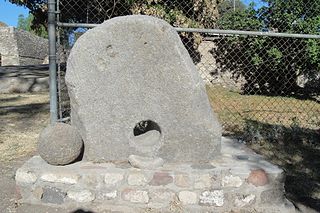
Huexotla or Huexotla is an archaeological site located 5 kilometers south of Texcoco, at the town of San Luis Huexotla, close to Chapingo, in the Mexico State.
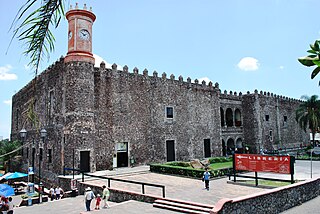
The Palace of Cortés in Cuernavaca, Mexico, built between 1523-1528, is the oldest conserved colonial-era civil structure in the continental Americas. The architecture is a blend between Gothic and Mudéjar, typical of the early 16th century colonial architecture. The building began as a fortified residence for conqueror Hernán Cortés and his aristocratic second wife, Doña Juana Zúñiga. It was built in 1526, over a Tlahuica Aztec tribute collection center, which was destroyed by the Spanish during the Conquest. Cortés replaced it with a personal residence to assert authority over the newly conquered peoples. As Cortés's residence, it reached its height in the 1530s, but the family eventually abandoned it due to on-going legal troubles. In the 18th century, colonial authorities had the structure renovated and used it as a barracks and jail. During the Mexican War of Independence, it held prisoners such as José María Morelos y Pavón. After the war, it became the seat of government for the state of Morelos until the late 20th century, when the state government moved out and the structure was renovated and converted into the current Museo Regional Cuauhnahuac, or regional museum, with exhibits on the history of Morelos.
Acapantzingo is a barrio in the southeastern part of the City of Cuernavaca, Morelos, Mexico, 2 km from the city center. The Nahuatl name means on the slope of the reeds. It is bound by the Río Chalchihuapan on the west, Colonia Atlacumulco, Jiutepec to the east and south, Colonia Palmira to the south, and Calle Cuauhatemoc to the north.
| Wikimedia Commons has media related to Teopanzolco . |
Coordinates: 18°55′49.61″N99°13′19.25″W / 18.9304472°N 99.2220139°W